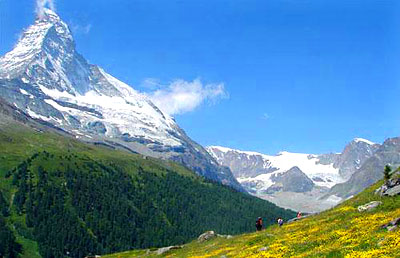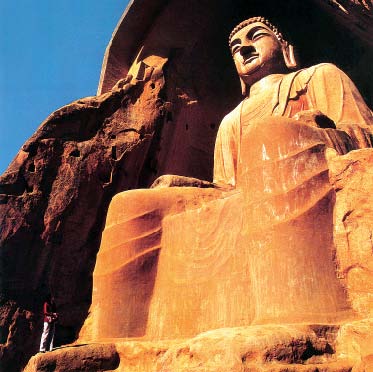| Five-day tour in Ningxia | |||
|
|||
|
Although Ningxia is the smallest province in China in terms of area, it boasts plenty of tourist attractions, such as the Great Wall of the Ming Dynasty (1368-1644) in the Helan Mountains; the ruins of ancient mountain passes; the Pyramid-shaped Imperial Tombs of the Western Xia Dynasty; and the grottoes in the Xumi Mountains. Some tourism activities are also very interesting, such as visiting the local irrigation project, a great success in harnessing the Yellow River; rafting on the Yellow River on a sheepskin raft; enjoying the setting sun on a camel in the desert; and visiting the homes of Hui ethnic groups.
There are a variety of choices to tour Ningxia. Here the route of the 5-day tour: Day 1: Touring around Yinchuan City. As early as the Qin Dynasty (221-206 B.C.) and the Han Dynasty (206 B.C.-A.D 220), people in Yinchuan had begun to irrigate farmland with water diverted from the Yellow River. Thousands of diversion canals irrigated millions of hectares of barren land and turned it into a fertile place. The warp in this area is as thick as 600 meters, forming the most fecund farming zone in the northwestern China. Yinchuan is the capital city of Ningxia Hui Autonomous Region. It has many historical sites and cultural ruins. The Haibao Tower, which was said to be built about 1,500 years ago, is one of Ningxia's earliest constructions. The pagoda in the Chengtian Temple, which lies in the southwest corner of the old town, also has a history of almost 1,000 years. The Imperial Tombs of the Western Xia Dynasty, also known as "Chinese Pyramids," have only 8 mausoleums and more than 70 subordinate tombs left today, due to destruction through war and weathering.
"Helan" in Mongolian means "steed." The Helan Mountains, extending for more than 200 kilometers, has always been an important military fortress and a natural screen of Yinchuan. The Helan Mountains if the location of the Great Wall of the Ming Dynasty, ancient mountain passes and some historical sites including the Helan Temple, Yuefei Temple and Mosque. Day 2: Going to Qingtong Gorge by bus (about 66 kilometers), and visiting the reservoir and the 108 Pagodas. The Qingtong Gorge is in the southwest of the Yinchuan, and is the last gorge on its upper stream. The Qingtong Gorge Reservoir adds great charm to the surrounding environment and makes it a famous tourist attraction. The 108 pagodas stand in 12 rows on a slope beside the reservoir. They form a isosceles triangle with each row comprising an odd number of pagodas in the following order: 1,3,5,7¡19. It is said that 108 is a lucky figure, which can remove people's ill fortune. Day 3: Going to Zhongwei County by bus (about 115 kilometers), and visiting the Gao Temple in the north of the county, which was built in the Ming Dynasty. Then starting form the Gaodun Lake and touring the Tengger Desert. Zhongwei County is an important pivot connecting Ningxia and Gansu. The famous Gao Temple, located north of the countryseat, ahs almost 100 rooms, including the Nantian Gate, Wuyue Temple, Goddess Hall, Bell Tower and Drum Tower. All the buildings are constructed on high platforms that connect the city walls. Day 4: Going to Shapotou by bus (about 18 kilometers), then rafting on the Yellow River and visiting the Singing Sand Slope. The Singing Sand Slope is a sand embankment, formed while the Tengger Desert shifted southward. The many dunes on the embankment, when sliding down, make a noise that sounds like the humming of a song. It makes up the three famous "singing sand tourism attractions" together with the Singing Sand Hill in Dunhuang and the Singing Sand Cove in Baotou. In Shapotou tourists can float on the Yellow River on a sheepskin raft, or enjoy spectacular desert scenes while riding a camel. Day 5: Starting from Yinchuan and going to Sanying via Zhongwei (about 201 kilometers), to visit the grottoes in the Xumi Mountains. These were dug out of the cliffs of five contiguous mountains and extend for more than two kilometers. Now, only 20 grottoes are relatively well kept, compared with more than 130 in the Ming Dynasty.
Construction of the grottoes in the Xumi Mountains started in the Northern and Southern Dynasties (420-581), and continued during the Sui (581-618) and the Tang (618-907) dynasties. Now it has a history of more than 1,400 years. The grottoes were grandly constructed and neatly arranged. The statues inside exhibit a high level of sculpting skill. The statue of Sakyamuni is more than 20 meters high. Statues in different grottoes have different artistic features. In the grottoes are murals of flying Apsaras and female dancers and singers, as well as patterned decorations. Despite thousands of years of damage by weathering, tourists can damage by weathering, tourists can still distinguish the wonderful artistic skills attained by the craftsmen of more than 1,000 years ago. On the way back, tourists are recommended to visit Guyuan County in southern Ningxia-homeland of the Hui ethnic group. The mosque in Tongxin Count has strong Islamic characteristics. Tourists can buy Chinese wolfberry and sheepskins, both local products. Tourism know-how: while touring in Ningxia Hui Autonomous Region, tourists should observe various taboos of the local place. The wind speed in Ningxia's desert can reach force 6 on the Beau ford scale be as high as sixth grade, therefore visitors should wear wind-proof glasses while walking in the desert.
|
| Tools: Save | Print | E-mail |
|
| Comment |







